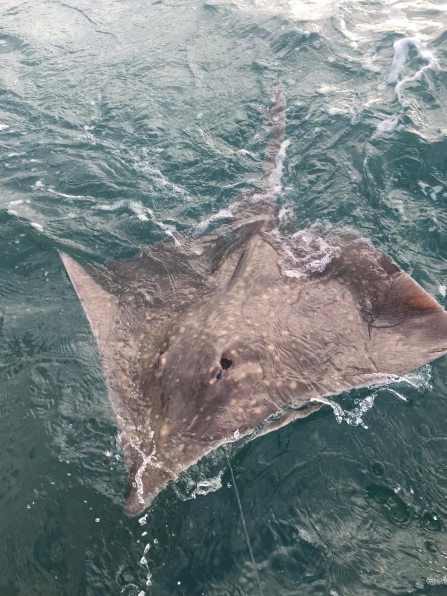The Flapper Skate (Dipturus intermedius) is the largest skate species in the world, measuring up to 3 meters long! It was once referred to as the Common Skate, however genetics has shown it is in fact two distinct species (Blue Skate and Flapper Skate). They live on the seabed, where they feed on crustaceans – having teeth like grinding plates to help break through the shells! The species is oviparous, laying egg cases to reproduce – they can lay up to 40 egg cases per species! Finding these egg cases on our local shores is incredibly rare, with the Sea Deep project only having one confirmed record!
Summary of Flapper Skate Working Group 1st Paper

The Flapper Skate is listed as critically endangered on the IUCN Red List. Whilst once abundant, overfishing in the late 20th century has caused this severe decline in the species. Existing legislation is in place, protecting individuals of the species but not focusing on population recovery. The Flapper skate is also a priority species under the UK Post-2010 Biodiversity Framework Priority Species, is protected under the EU fisheries legislation (making landing the species illegal), The Northern Ireland Wildlife Order (2011) and is offered further protection in Scotland (2012), with MPAs designated for the species. However, with all efforts, the species is still declining, and further conservation is needed. As such, the Flapper Skate working group was established, joining together organizations from all areas involving Flapper skate conservation, i.e., Governmental, Non-Governmental & Recreational, to discuss future collaborative attempts. The working group recently released a paper outlining recommendations for conserving the Flapper skate. Four conservation priorities were recommended (in no particular order). They have been outlined below.
Priority 1: Accurate taxonomic resolution
Previous legislation has regarded the Flapper skate species as the Common Skate (Dipturus batis), or even Raja batis (Raja housing other species of Skate) – an attempt to “group” together similar looking species. With further genetic research, this priority species is now named the Flapper Skate (Dipturus intermedius). However, current legislation still uses multiple names – creating confusion; and therefore, a common name within legislation is a priority recommendation of the flapper skate working group. To ease confusion further, the working group suggested that all species of skate be considered for similar legislative protection, due to shared data gaps and similar vulnerabilities in terms of over-exploitation.
Priority 2: Increase data on life history
The Working Group also investigated the reliability of previous studies surrounding the Flapper Skate. The results from these were accepted as accurate to respective research sites, however possibly not representative over the species’ range. Knowledge gaps were highlighted where further research will be required. The gaps included: species life span, reproductive rates, habitat and diet shifts whilst individuals are developing, sexual space partitioning and site fidelity (linking with territorial behaviors).
Priority 3: Increase regional approach to conservation
As mentioned, legislation protecting the Flapper Skate already exists; in well-documented areas where the species ranges from Shetland to Southern Ireland (Co. Cork). Whilst research has been conducted outside this range, the Flapper skate working group state for future conservation it will be necessary to interrogate these records; with possible further monitoring in these areas required. The paper appreciated the current efforts for Flapper skate protection, with recognition of the Loch Sunart Marine Protected Area, however as the Flapper skate is mobile, it was questioned if further ecologically connected MPA’s were required for protection on a regional scale.
Priority 4: Account for broader ecological shifts in Flapper skate conservation
The Flapper skate working group also discussed the probability of the Flapper skate returning to a “pre-collapse” species range. Due to anthropogenic pressures such as the threat of bycatch from trawling, this was deemed unlikely. Although difficult to counteract these threats, possible alternatives were discussed such as “Excluders” built into fishing nets, that would reduce the by-catch of skate species. Other methods were discussed, with the consensus being further research is required. Alongside bycatch, habitat degradation and climate change were included as stressors to future conservation consideration. Whilst these are challenge to mitigate for, the Flapper skate working group considered consideration of these aspects essential if species conservation was to be achieved.
Summary
With regards to the recommendations outlined, the Flapper skate working group created a list of priority recommendations focusing primarily on the known range of the species. These were split into three distinct areas: Outreach, Advocacy and Research. These are outlined below:
- A Linnean System (Latin names) should be used for all Policy Documents to avoid species confusion.
- Identify key habitats used by the Flapper skate i.e., Breeding Grounds.
- Develop a system of inter-connected Marine Protected Areas to ensure genetic species are protected throughout the region they inhabit.
- Develop shared educational resources to avoid duplication of effort and provide a unified conservation message.
- Engage with and further develop public interest, creating a sense of public responsibility towards Flapper skate conservation.
- Produce a guidance document aimed at conservation managers and policy workers.
- Agree upon a standardized approach to data collection with regards to bycatch/angling records.
The Sea deep project is working to safeguard the future of the Flapper Skate in Northern Irish waters. The project will continue to support any work undertaken by the Flapper skate working group to ensure effort to conserve these species within the wider Flapper skate region continues. To find out more about the Sea Deep project, and how to get involved check out the Sea Deep Website!

